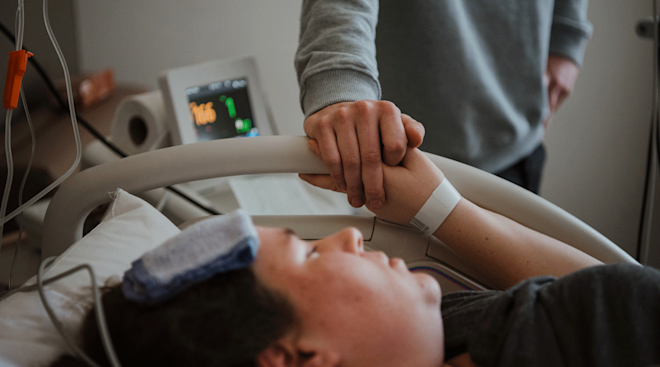Wait… Is Lamaze Still a Thing?
Tie-dye, love-ins, Lamaze classes. If the Lamaze method of preparing for birth sounds like a relic of the 1960s, that’s because it kind of is. That’s when that characteristic “hee-hoo, hee-hoo” breathing technique you may have seen in movies and sitcoms became popular in the US. “It was standard for past generations to be expected to take classes before their due dates,” says Annie Lawson, CNM, a certified nurse midwife at Atlantic Health System in New Jersey. “My mom took it when she was pregnant with me in 1974,” shares Kristin Revere, CED-L, NCS, a newborn care specialist, doula, and the owner and founder of Gold Coast Doulas in Grand Rapids, Michigan.
But Lamaze class isn’t just a thing of the past. The method has evolved into a comprehensive approach to help you prepare for childbirth and motherhood—and Lamaze class is likely available in your area. “Lamaze is such a great foundation, whether you’re planning to go unmedicated or you’re open to an epidural,” says Bethany Scott, RN, a birth doula and the owner and founder of Lemontree Babies in Rowayton, Connecticut. “It’s not about doing things ‘right’ or perfectly—it’s about feeling confident, prepared and supported.” Ahead, learn more about benefits of the method, what to expect in a class and more.
If you associate Lamaze with childbirth classes that teach breathing, you’ve got the idea—but there’s more to it. “Hands-on Lamaze used to be known for paced breathing,” says Revere, who took Lamaze during both her pregnancies. “But it’s so much more now.” During the program, you learn strategies to help you navigate labor, like conscious breathing for pain management. You also get a general education on childbirth to help you decide which approaches will work best for you. But the core of Lamaze are its six healthy birth practices, which are outlined below.
The Lamaze 6 healthy birth practices
The foundation of the Lamaze philosophy are the healthy birth practices, which the organization says are based on years of research:
- Let labor begin on its own. Unless there’s a medical reason for you or baby, the organization believes the healthiest outcomes will occur if you let childbirth begin on its own.
- Move around, walk and change positions. Moving around can help with the pain of contractions—and can help baby make it through your birth canal.
- Bring a loved one, friend or doula for support. Being surrounded by people you trust will make you feel more safe and secure during this important moment.
- Avoid interventions unless medically necessary. Although this may be controversial, Lamaze International states that interventions such as epidurals may be harmful, and to avoid them unless absolutely needed.
- Avoid giving birth on your back. Lamaze believes in following your body’s natural urges to push—in whatever position that may be.
- Keep a mom and baby together after birth. Practicing skin-to-skin with your newborn is best for Mom, baby and breastfeeding.
In the late 1950s, Marjorie Karmel published the book Thank You, Dr. Lamaze, which popularized a childbirth method introduced by French obstetrician Fernand Lamaze a few years earlier. The method was inspired by practices Lamaze had observed in Russia. In 1960, Karmel co-founded a nonprofit organization (now Lamaze International) to help promote the mission. It worked: “Lamaze is still popular and respected in [some] circles for childbirth preparation,” says Kecia Gaither, MD, MPH, associate professor of clinical obstetrics and gynecology at Weill Cornell Medicine and director of perinatal services at NYC Health + Hospitals/Lincoln.
Lamaze seems to get a bad rap because of the hokey breathing techniques (think ‘80s sitcoms). That said, my husband and I took Lamaze and found it decently helpful. We did learn some breathing exercises (none of which I ultimately used), but I found the various laboring positions and counter-pressure techniques to be pretty useful.
In Lamaze, you’ll learn several breathing techniques, since different ones work best at different labor stages. “It’s kind of like having a playlist,” Scott says. “You start with the slow jams to chill at first, then switch to something with more energy when the vibe changes.” In early labor, long, slow belly breaths can help you relax. But when contractions become more intense, quicker, shallower breathing can assist with focus and pain management. That’s when the well-known Lamaze “hee-hoo, hee-hoo” breathing comes in. You take two short breaths (pants), then quickly exhale (blow). Repeat the pattern, speeding it up as the contractions intensify.
To practice Lamaze breathing, start by paying attention to your breath. Then experiment. Inhale through your nose and exhale through your mouth, holding for different counts. See how different approaches make you feel. “If you practice a few styles during pregnancy, your body will know what to do when the time comes,” says Scott.
Childbirth prep classes like Lamaze can help you make informed decisions and feel more in control during the birthing experience. The techniques you learn can also help you actively manage labor and delivery pain. “Lamaze technique can reduce the perception of pain and potentially reduce the need for pain medication,” says Lawson. “It can also shorten the length of labor and reduce the likelihood of interventions in labor.” Plus, Lamaze class provides a way to meet other parents-to-be. Some will likely become part of your support network—which is crucial, especially in the early days of parenthood.
We did Lamaze with our first pregnancy, and I’ll take a refresher with this one. I think there's a lot of value in it. Yes, you can wing it and nurses can tell you how to push, but there's a lot of labor that takes place without nurses if you hope to labor at home and try and go without an epidural for any length of time. Lamaze gives you and your partner a lot of different tools to work with and some that even help with those pregnancy aches and pains.
Childbirth can be beautiful—but it can also be unpredictable. Even if you originally plan on a medication-free birth, you might end up opting for an epidural or needing a C-section. So while taking any birth prep class is ultimately valuable, it’s important to keep an open mind about what happens in the delivery room. “Some critics argue that while Lamaze promotes natural childbirth, it may not adequately prepare women for situations when medical intervention becomes necessary,” says Gaither. Just remember, “there’s no one right method over another,” adds Kyle Graham, MD, a board-certified ob-gyn at Pediatrix Medical Group in San Jose, California. Don’t blame yourself or feel you’re at fault if the Lamaze method doesn’t work for you. At the end of the day, what’s most important is a healthy mom and baby, not adherence to a specific birth plan.
Lamaze isn’t the only approach when it comes to childbirth prep. “There are many similar techniques that can be utilized in childbirth,” says Graham. The Bradley Method is like Lamaze in its emphasis on a partner-coached natural childbirth. HypnoBirthing combines breathwork and physical positions with visualization and affirmations. Birthing from Within teaches practical childbirth skills and helps prepare you psychologically for motherhood. You can also explore conscious breathing techniques. “Mix and match to find what fits your vibe,” says Scott.
“Think of it like a birth bootcamp, but fun and not intimidating,” says Scott. During the multi-week class, you’ll learn what happens during labor, different ways to cope, how your partner can help you, and the basics of postpartum recovery and baby care. “It’s not just lectures. You get to practice the techniques, meet other parents and walk away feeling so much more ready,” says Scott.
To find a Lamaze class near you, ask your doctor or midwife for a recommendation. Or plug your zip code into the search field on Lamaze.org to find instructors in your area, suggests Scott. When evaluating courses, make sure teachers are certified to teach Lamaze.
Frequently Asked Questions
Is Lamaze breathing the same as conscious breathing?
Conscious or coherent breathing means being aware of your breathing and, usually, controlling your breathing. Different styles of conscious breathing are among the many skills Lamaze teaches. There’s no one “Lamaze” breathing style.
When should you learn Lamaze?
Start at 30 to 32 weeks pregnant, suggests Scott. That way, you should have enough time to experience the full curriculum and practice the techniques when they’re needed, say during a stressful day or while having Braxton Hicks contractions.
When during labor should you begin Lamaze breathing?
“Whenever you need to,” says Scott. “In early labor, slow breathing helps you relax and avoid burning out too fast… Once things ramp up, patterned breaths help you stay focused and prevent spiraling. It’s your go-to tool from start to finish. It grows with you as labor progresses.”
What is the 4-7-8 breathing technique?
The 4-7-8 breathing technique was originally based on pranayama, the breath control practice from Ayurvedic medicine. Scott suggests using it to combat pre-labor anxiety. “It’s like a chill pill in breathing form,” she says. “It’s not technically Lamaze, but it’s amazing for calming your nervous system.” To try it, close your mouth and inhale through your nose for 4 seconds. Hold your breath for 7 seconds. Then exhale through your mouth for 8 seconds. Repeat three times.
“Preparing for childbirth can seem overwhelming,” says Lawson. “But the more you learn about stages of labor and ways to help navigate the process, the better prepared you’ll be on the big day.” When push comes to shove (pun intended), Lamaze can help you feel more confident throughout the whole process.
Please note: The Bump and the materials and information it contains are not intended to, and do not constitute, medical or other health advice or diagnosis and should not be used as such. You should always consult with a qualified physician or health professional about your specific circumstances.
Plus, more from The Bump:
Kecia Gaither, MD, MPH, MS, MBA, FACOG, is a double board-certified physician in ob-gyn and maternal-fetal medicine specialist and the director of perinatal services and maternal-fetal medicine at NYC Health + Hospitals/Lincoln. She also serves as an associate professor of clinical obstetrics and gynecology at Weill Cornell Medicine. She earned her medical degree from SUNY Health Science Center in Syracuse, New York, and holds a master’s degree in public health.
Kyle Graham, MD, is a board-certified ob-gyn at Pediatrix Medical Group in San Jose, CA. He earned his medical degree from Keck School of Medicine at the University of Southern California in 2015 and has gone on to practice worldwide, including medical missions in Uganda and Guatemala.
Annie Lawson, CNM, is a certified nurse midwife at Atlantic Health System in New Jersey.
Kristin Revere, MM, CED-L, NCS, is a newborn care specialist, doula, and the owner and founder of Gold Coast Doulas in Grand Rapids, Michigan. She’s also a host of the Ask the Doulas podcast.
Bethany Scott, RN, is a birth doula and the owner and founder of Lemontree Babies in Rowayton, Connecticut. She’s also a host of The C-Section Experience podcast.
Arizona Center for Integrative Medicine, 4-7-8 Breath Relaxation Exercise, February 2010
Lamaze International, 6 Healthy Birth Practices
Lamaze International, History and Myths
Scientific Reports, Effect of Coherent Breathing on Mental Health and Wellbeing: A Randomised Placebo-Controlled Trial, December 2023
The Journal of Perinatal Education, Lamaze Breathing: What Every Pregnant Woman Needs to Know, Spring 2011
Real-parent perspectives:
Learn how we ensure the accuracy of our content through our editorial and medical review process.
Navigate forward to interact with the calendar and select a date. Press the question mark key to get the keyboard shortcuts for changing dates.





















































